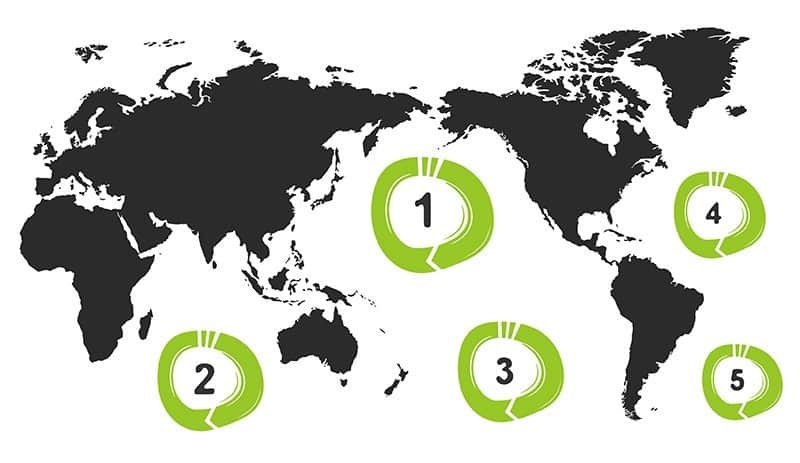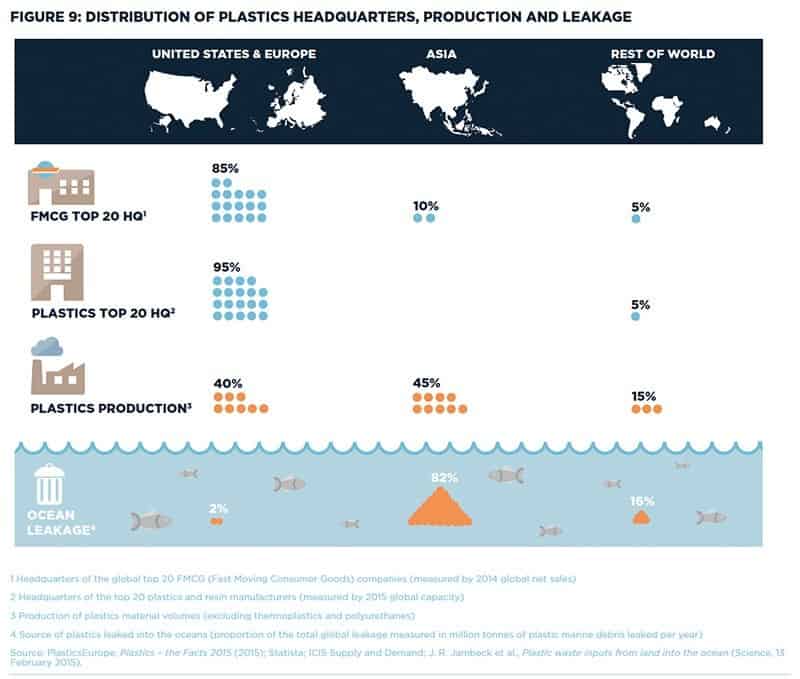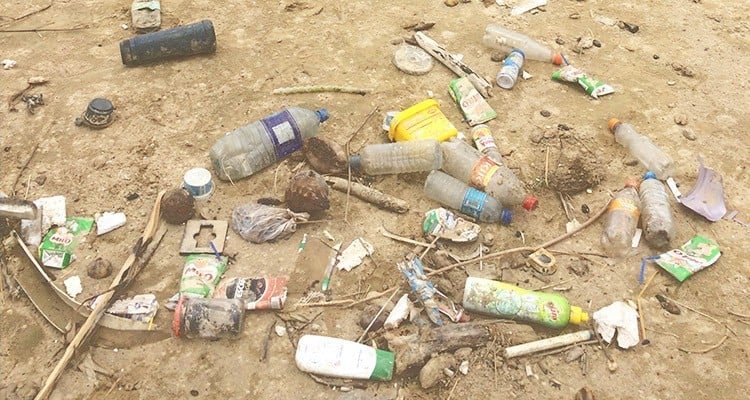The 5 giant Garbage whirlpool in the seaIn my opinion, plastic waste, which makes its rounds in the ocean currents, is too rarely a topic in the media. There are millions of tons of plastic waste floating in the sea and the pictures of it are more than frightening. The gigantic garbage whirlpools of plastic waste are representative of our unconscious consumption, lack of education and inadequate recycling systems. With this article I would like to draw your attention once more to the gigantic garbage whirlpools in our oceans. In this article I will introduce you to the 5 biggest garbage whirlpools in the oceans, explain the origin and consequences of plastic waste in the sea and show you what each of us can do immediately against the growing garbage whirlpools.
Here is another short Table of contents about the article:
- 5 huge garbage whirlpools in the sea
- Origin of the sea whirlpools
- Origin of the plastic waste of the garbage strudel
- Consequences of the garbage whirlpool
- What we need to do about the waste whirlpools
- Conclusion
These are the 5 huge garbage whirlpools in the sea

The waste whirlpools are all located near the equator, because this is where the ocean currents from the north and south meet and bundle the waste in the sea. Unfortunately, the size of each can only be guessed at the moment. Garbage whirlpools are constantly in motion and therefore no meaningful geographic or political boundaries of the garbage whirlpools can be established. This is also a reason why many people question the existence of the waste whirlpools. Unfortunately, I can only give you facts about the North Pacific garbage whirlpool, but I am trying to get figures for the other 4 large garbage whirlpools in our oceans.
- North Pacific Garbage Vortex: The Great Pacific Garbage Patch in the North Pacific Current is the best known because it is the largest garbage whirlpool in our oceans. It is estimated to have a size of 700,000 to more than 15,000,000 km². Under certain circumstances, this one garbage whirlpool alone is larger than Europe. At least one piece of plastic is said to float in this ocean vortex per square meter. Especially the island of Hawaii is affected by this garbage vortex.
- Indian garbage vortex: The garbage whirlpool is in the South Indian Current Circle.
- South Pacific Garbage Vortex: This is the garbage vortex in the South Pacific Current.
- North Atlantic Garbage Vortex: This waste vortex bundles the plastic waste in the North Atlantic current circle. Here, about 0.2 plastic particles float on every square meter.
- South Atlantic Garbage Vortex: The trash swirl in the South Atlantic Current is also huge.
It is estimated that there are about 1000 - 2500 g of plastic waste floating in each of these waste whirlpools per square kilometer.
How did the garbage whirlpools form in the first place? Why does the garbage collect at these 5 ocean eddies and where does all the plastic garbage in the garbage eddies actually come from? I would now like to answer these questions in more detail.
Origin of the garbage whirlpools in the sea
First of all, I would like to give you the scientific background of the garbage whirlpools in the sea and explain why the ocean currents exist. These are the natural and scientific reasons for the ocean vortices:
- Meeting of warm winds from the tropics and cold winds from the polar regions
- Different water temperatures due to the alternation of tropical, temperate and polar climate zones₂.
- Salinity of the water₃
- Earth rotation (clockwise flow circles of ocean vortices in northern hemisphere, counterclockwise flow circles in southern hemisphere)
It is through the resulting ocean eddies and our unconscious handling of plastic waste that the large waste eddies in the sea occur in the first place. But where exactly does the garbage originate?
Origin of the plastic waste in the waste strudels

There are significant studies on the origin of the plastic waste in the waste whirlpools. I refer to the detailed study "The New Plastics Economy" by the Ellen MacArthur Foundation₄. The result shows that the industrial continents such as North America and Europe are responsible for nearly half of the world's plastic production, but only about 2% of the plastic waste in the ocean is generated directly by them. Southeast Asia has a real plastic waste problem, because these developing countries are responsible for about 80% of the plastic waste in the ocean. Developing countries in Africa and South America also have a high share of plastic waste in the sea. In these countries, poor recycling systems, lack of education and, as a result, unconscious consumption are the order of the day. For these very reasons, plastic is rarely recycled. The garbage ends up in landfills and blows into the sea, if it is not already directly into the sea. Plastic was suddenly there and had many advantages. Now we get to see the disadvantages due to the garbage whirlpools and urgently need to do something. Here is another video that describes the garbage whirlpools in their formation very well.
80% of the plastic waste of the garbage whirlpool comes from land
According to the study Plastic Debris in the World's Oceans₅ conducted by Greenpeace International, about 80% of the plastic waste in the sea is generated on land. Sooner or later, the weather ensures that the waste reaches the sea either directly from the mainland or via rivers.
So it is by no means possible to simply claim that only beachgoers are to blame for the plastic waste in the sea. No, it's all of us. Because even a household in Frankfurt, in the middle of Germany, far from the sea, is driving plastic waste into the sea every day. How? Through Microplastics in cosmetics or by washing the laundry, which also contains plastic fibers.
These are the components of the plastic waste in the garbage swirls

The things that swirl around in the trash swirls are exactly the same things that you find on the littered beaches of our earth. For example, in the trash swirls float...
- ... masses of plastic bags
- ... unbelievable amount of plastic bottles
- ... yogurt and drink cups
- ... care items such as disposable razors, shower gel bottles or toothbrushes.
- ... buckets, barrels or canisters
- ... lighters, straws, beer cans and glass bottles.
- ... Packaging of sweets
- ... old fishing nets (so called ghost nets), lines or cables.
- ... but also organic waste such as coconut shells or banana peels.
- ... this could now go on indefinitely.
We find pretty much every kind of plastic waste in the garbage swirls. This shows once again that the plastic objects themselves are not the problem, but only the fact that we handle them poorly.
What do garbage eddies in the sea mean for nature?
You certainly know that plastic is not biodegradable. I recommend you also my article What is plastic anyway? to read. The plastic may "decompose" over many decades into smaller microplastics, but once it is created, it remains forever. This also applies to the Plastic waste in the environment and in the sea.
"Every little piece of plastic that was manufactured in the last 50 years that got into the ocean is still there somewhere." - Tony Andrady, chemist at the American Research Triangle Institute.
So every piece of plastic waste that we allow to enter the oceans is still out there and has to be collected again. That's because marine animals eat pieces of plastic. The toxic plastic, for example, passes into the cells of fish, which eventually end up back on our plates. What consequences Plastic in the food chain has on our health is still largely unexplored. But it cannot be healthy.
The devastating consequences of the garbage whirlpools in the sea
We can't just ignore the plastic waste whirlpools, because they are getting bigger every day. By 2050, there will be more plastic waste in the ocean than there are fish. We are destroying our planet and eliminating the waste vortices is our last chance. Now and not in 3o years. Here I would like to explain the consequences of the garbage whirlpools for our health, for nature and for the animal world:
- Animals die in agony: Animals mistake plastic waste for food and die a long, agonizing death from the plastic in their stomachs. They strangle themselves on nylon ropes, nets or six-pack rings. Every year, another 10 million tons of plastic waste enter the sea, costing the lives of 1,000,000 seabirds and 100,000 marine mammals every year.₆
- Plastic waste binds pathogens: We must not forget that the plastic waste in the garbage stacks attracts bacteria and thus transports pathogens to the other side of the world, where the diseases may not have existed before.
- Microplastics enter the food chain: With every piece of plastic, the threat to humans and animals increases. This is because plastic does not simply disappear. Over the course of centuries, the plastic waste from the garbage drums decomposes through the weather into smaller microplastics that are eaten by fish. The plastic passes into the cells of the animals that we later have on our plates. Learn more here about Plastic in the food chain.
We have created one of the biggest environmental problems of our time through the garbage eddies in the sea. It is time to correct this mistake.
What can we do about the garbage whirlpools?
There are many really good projects against the garbage whirlpools in the sea or against the basic problem of plastic waste in the environment. I will present these to you in a detailed, separate article. Here I would like to explain to you now rather finally, what each individual of us can do immediately against the garbage whirlpools in the sea.
- Live plastic-free: By living plastic-free, you'll make very little plastic waste yourself, live healthier and be a role model for other people. Learn here how you can easily go nearly plastic free living simply by following your heart.
- Support and organize CleanUps: I organize some myself, but usually, no matter where you are, you can always participate in CleanUps and clean up the plastic waste in nature with your own hands. It gives you an incredibly good feeling, believe me. You can also just start an action yourself! You can join our global CareElite CleanUps Facebook group here..
- Consciously consume: The unconscious consumption in combination with the lack of education is the main cause for the 5 big waste whirlpools in the sea. By consciously buying sustainably, you do something for the environment and against the waste whirlpools. Take a look at the plastic free store and get inspired.
- Pass on your environmentally conscious attitude: You are a role model! Share your attitude and try to create a hello-wake-up effect in others. Only a change in the awareness of all people can save us from having more plastic in the sea than fish in 2050.
Conclusion - garbage vortex in the sea?
The garbage whirlpools in the sea are there. And they continue to grow with each passing day. Diseases are being transferred to new areas, more and more microplastics are getting into the cells of fish, and masses of birds and marine mammals are dying as a result of the waste-laden ocean eddies. It's long past fun and we need to act. Because the trash problem is getting out of control. But together we can eliminate the garbage whirlpools. Through conscious consumption and a new, contemporary awareness. The Zero Waste lifestyle gives a lot of hope.
I look forward to your opinion, questions or suggestions.
Best regards,

PS.: If you have scrolled up to here -> Be sure to join our global Facebook group CareElite CleanUps and who knows: Maybe you will soon organize your first own CleanUp against the further growing garbage whirlpools!
References:
₁ https://www.theoceancleanup.com
₂,₃ https://de.wikipedia.org/wiki/Meeresströmung
₄ The New Plastics Economy, http://www3.weforum.org/docs/WEF_The_New_Plastics_Economy.pdf
₅ http://www.greenpeace.org/international/en/publications/reports/plastic_ocean_report
₆ NABU - https://www.nabu.de/natur-und-landschaft/meere/muellkippe-meer/muellkippemeer.html






Hello Christoph,
I have been interested in the topic for a while and am now also writing my KL (complex leistung in class 10) about plastic pollution and an important sub-point is the garbage eddies. I have a question: How big are the individual garbage whirlpools?
Many love greetings!
Jana
Hey Jana! Thanks for your message. For example, in the Great Pacific Garbage Patch, the garbage moves in 1.6 million square kilometers. For comparison, Germany has an area of 357,386 square kilometers.
Many greetings
Christoph
Hello dear Christoph,
I am writing a scientific paper on the topic "Plastic in the ocean". A sub-item in my work are the garbage eddies. At this point I would like to take some information from your very interesting article (of course correctly quoted ?;) ). Since I quote some details also indirectly, I wanted to make sure, if it fits, if I title you as "Christoph Schulz, a plastic waste CleanUp organizer". Or how may I call you ?
Thanks in advance ! And also thanks for the great article !
Kind regards,
Maximiliane
Hello Maximiliane,
Thank you for your request! Haha, you're welcome to write environmental activist or environmental entrepreneur. Your title might be a bit too long after all 😉
Good luck in any case!
Many greetings
Christoph
Hello,
I'm shooting a video on the subject with a friend for a presentation. Would it be ok if we use your graphics?
Hello Julia! I think that's great. If you always indicate the appropriate source, you can of course use the respective image.
Best regards
Christoph
Good day Christoph
Thank you for your report.
My husband and I live in Greece (Peleponnes) for half the year. The people there throw their garbage for the most part into the ravines. In our village I have raised this problem with the village president many times. On the beach we collect a bag of garbage after each visit. All completely unsuccessful.
Do you have experience with how to make a population aware of the waste problem without them feeling lectured by us foreigners? (We are Swiss)
Best regards, Eva
Hello Eva! On the one hand very sad - on the other hand great of you! Phew, so the educational work works well, especially if you get local support. Sometimes you need special motivation, for example you could organize a garbage collection competition with prizes as a reward 🙂
I wish you maximum success!
Many greetings
Christoph
nature can do without us but we cannot do without it
Hello Günther! True words!
Many greetings
Christoph
Irresistibly, the flood of plastic in the oceans will destroy all life.And the polluters
MM (mass man) too.
Is just !
Hi Heinrich, if we don't adapt our way of life to nature, it will happen eventually. Not only by the plastic waste in the environment, but also by the Climate Change, by Soil Erosion, through the Water Shortage and through all other major Environmental problems of our time.
That's why it's so important, live sustainably. And it's not that complicated.
Best regards
Christoph
If you talk about it why do not you do for the environment. Talking doesn't help, you have to do something? it's only going to get worse?
Hi Anastasia! The article is for clarification, if that's what you're referring to 🙂 Of course, everyone has to become part of the solution in their everyday life. Have a look at the article Plastic free living in!
Many greetings
Christoph
I think this site is really great. It has really helped me. However, I have a question:
(On the second point about the devastating consequences).
What is meant by "binds pathogens"? Is that a typo or is it really meant that way? And if this is correct, how can I best explain this?
LG Lyra
Hi Lyra! Thanks for your feedback!
Plastic is an excellent material for pathogens to bind to. For example, they travel through ocean currents from Africa to America - and generally from places where they exist to places where they did not exist before.
I hope that I have been able to help you.
Best regards
Christoph
Hello Christoph,
I am also in the process of creating a presentation on this topic. I like your site very much, but I asked myself the question, where does the garbage collected during the CleanUps go?
Somehow the garbage ends up that way, e.g. in landfills, in the sea.
LG Vero
Hi Vero! Great 🙂
Do you mean the trash that is collected at CleanUps? You can give it to organizations that recycle and upcycle trash. In Bali, I worked together with EcoBali.
Best regards and good luck with your Präsi,
Christoph
Yes, that's the one I mean. Ah okay, thank you very much.
Thank you!
LG Vero
Hello Christoph,
I am in the process of developing a presentation on this topic. I like this site very much, but I asked myself the question, what happens with the garbage that is collected during such CleanUps?
Often the garbage somehow ends up in the sea again.
LG Vero
Hi Vero! I hope your presentation went great! I dispose of the garbage in consultation with nearby waste companies on site. In Bali, for example, this was the company Eco-Bali. I then pay a small fee for the disposal. The company then recycles and upcycles the garbage and makes cool glasses out of glass bottles, for example.
Best regards
Christoph
Hello Dear Christoph I'm writing a paper about this topic your contribution is very useful to me is a super job you have done Thank you. LG Juleen ?
Hi Juleen, thank you for your feedback - I'm delighted! 🙂
Good luck and best regards,
Christoph
I am very happy to have come across your article! I'm currently writing a geography paper about the islands in Hawaii and their possible problems e.g. related to tourism, which might decrease in the future as Hawaii is more and more affected by garbage on the beaches. The North Pacific Garbage Patch is one of the main causes of this and this has been explained very well in your article, thank you! If you have some more information or statistics on the topic of trash flows especially as it relates to Hawaii and its impact, I would greatly appreciate it!!!
I would be delighted to receive an answer 🙂
Hey Nika! Thanks for your feedback 🙂
Unfortunately, that's all I've been able to research so far. Contact The Ocean CleanUp in the Netherlands - with a little skill you can get great statistics without much effort!
Many greetings and good luck with the technical work,
Christoph
Thank you very much anyway, that's a great help! 🙂
Always happy to help 🙂
Hello Cristoph,
I am writing a diploma thesis about the topic "pollution of the oceans". In my thesis I also deal with plastic waste including garbage whirlpools, so I wanted to ask if I could include the graphic of the five garbage whirlpools in my work.
Love greetings
Simone 🙂
Hi Simone,
You are welcome to use the graphic with the garbage swirls (CareElite logo's). Good luck with your thesis.
Many greetings
Christoph
Not only the size of the plastic whirlpools is frightening, but rather the range with which plastic creeps into our ecological niches. The decomposing macroplastic not only gets into the stomachs of the fish world and finally on our dinner plates, but is inhaled by us as microplastic through the atmosphere.Thereby parts of nanometer size reach the respiratory chain via the bronchilasystem and are part of the alveolar exchange with direct or indirect influence on the bioenergetic energy production of our organism. The dimension of resulting diseases from the inhalation and not least through food ingested molecular plastic particles goes far beyond the idea of resulting diseases like allergies and cancer. The final influence on our biogentic genetic material with pathological disturbance of our DNA sequences can only underline the extent of the catastrophe threatening us. A rethinking in all areas of life is an immediate must and represents the appeal to all responsibility-thinking people to check the consumption and handling of plastic-containing products, to reconsider and in the last consequence to avoid them.Parallel to this step, which represents the exit of all evil, it applies to turn over initiatives of equally thinking citizens to already established environmental organizations and by petitions to the governments of our states. It applies to remove existing plastic garbage from the oceans and states, which need due to your infrastructure assistance this environmental problem technologically to solve, to support.A far-reaching education through all available media television, radio, etc. must be the goal in the highly technical industrialized countries, an extensive education of socially disadvantaged sections of the population in developing countries, which live largely from fishing must find support in all responsible political bodies.corporations must be informed and find government support to develop alternative plastic-free products and those that contain plastic, to mark and declare the handling and disposal to the recikling.It is time that we find each other and finally act.
Hello Michael,
Thank you for your comments, which I can of course confirm. I would also like to add that it is important that we finally act HONESTLY.
The trend is finally moving in the right direction, but there is still a lot of educational work to be done.
Best regards
Christoph
Hi Christoph!
First of all, I have to say that I think your blogs are great and have helped me a lot.
I'm currently writing a paper about plastic pollution in the world's oceans and wanted to ask if I could use your plastic vortex graphic 😉
Hi Fabi! Great, feel free to use with source CareElite.de 🙂
Good luck and thanks for your feedback.
Greeting Christoph
Pleased to meet you, thank you!
Lg Fabi 🙂
THANKS TO THE SEA!
Thank the sea for collecting plastic waste and making it available for collection by the idiots who dumped it in the sea.
Moin Frank,
unfortunately, it is usually not the people who threw it in who fetch it out of the sea. But those who have the problem with the Plastic waste in the environment have understood.
Stay clean,
Christoph
Hey Christoph,
I am giving a lecture on "Garbage and Poison in the Sea" at the university.
So I would like to ask you this way if you could mail me some more information about the subject.
Thank you in advance.
Hi Janina, I think that's great 🙂
You can find all the info here online, e.g. in the article Plastic waste in the environment. For more in-depth information, you can check out TheOceanCleanUp or get statistics from Statista.
I hope that I have been able to help you.
Stay clean,
Christoph
Hello Christoph,
My friend and I are giving a lecture in natural history on the topic of trash swirls.
We are from Switzerland and wanted to ask you if you could email us some more information on the subject. Like other organizations that are working on this or small brochures.
Kind regards
Blerta and Joelle
Hi Blerta,
great, have written you an email 🙂
Love greetings
Christoph
Cool action esnsollten more people read
Hi Max,
thank you! Will hopefully come so that we all create a new awareness of the garbage problem.
Many greetings,
Christoph
I was preparing a paper about the huge plastic islands when I came across this site. It helped me with my paper as well as understanding the huge amount of waste.
I knew myself that there are them (the garbage islands in the sea), but that it has such a big impact on our environment I was not aware before. thank you (you) for this great article. Now I will try to think more about the plastic problem and of course do something about it.
with kind regards:
Lilly
Hi Lilly,
You've chosen a big and important topic, very good. I'd be interested to know how your classmates reacted to it 🙂
Glad you are aware of this problem! Keep it up.
Many greetings,
Christoph
Dear Christoph, I was also wondering. You write that the garbage vortex in the Pacific has an area of 15 million square meters and is thus larger than Europe. Europe has to my knowledge an area of 10, 18 square kilometers maybe it is a typo, this should be changed anyway...otherwise super that you stand up for this important issue...greetings Anne
Hello Anne, Europe has an area of about 10 million square kilometers, the garbage vortex is estimated to be about 15 million square kilometers. It all fits 🙂
Best regards
Christoph
Good day, Christoph!
No that just doesn't fit. You write in the article, "It is estimated to range in size from 700,000 to more than 15,000,000 sq km." Not sqm, but sqkm is correct!!!
That is what Anne meant. She is right.
What remains to be questioned, however, is the somewhat very large spread of the "estimated size" of this vortex from 700,000 to 15,000,000 sq km! 1,600,000 sq. km is given as estimated size in: "Evidence that the Great Pacific Garbage Patch is rapidly accumulating plastic"! See: Scientific Reports Volume 8, Article number: 4666 (2018), March 2018.
A general problem is and remains the poor congruence of figures on one and the same facts in different sources. But one thing is and remains: It is 2 minutes to 12 o'clock, ladies and gentlemen!
Moin! Absolutely right, everything should now fit!
That's right, it's 5 to 12!
Stay clean,
Christoph
Hello Christoph,
Unfortunately, your article says "sqm", which is not an abbreviation for square kilometers by any stretch of the imagination. 15 million square meters are therefore about 15 km², about 1 millionth of the area of the EU.
Best regards
Markus
Hi Markus, thanks for your tip! Has been corrected 🙂
Stay clean,
Christoph
Dear Christoph,
in the quite interesting article on the subject of garbage vortices in the ocean, I came across an error. To the (1.) Great Pacific Garbage Patch I noticed that you indicate that it flows in the North Pacific, nevertheless should be in the North Atlantic current circle. In my opinion there is an error here, if this is not so please excuse the error.
With kind regards
Lene
Hello Lene, is adjusted. Thanks for your hint!
Best regards
Christoph
Hello Christoph,
Why do salinity and water temperature play a role in the formation of garbage swirls?
Hi Ella. Because both are causes for the formation of ocean currents, which ultimately transport our garbage. I hope that I could help you further.
Many greetings
Christoph